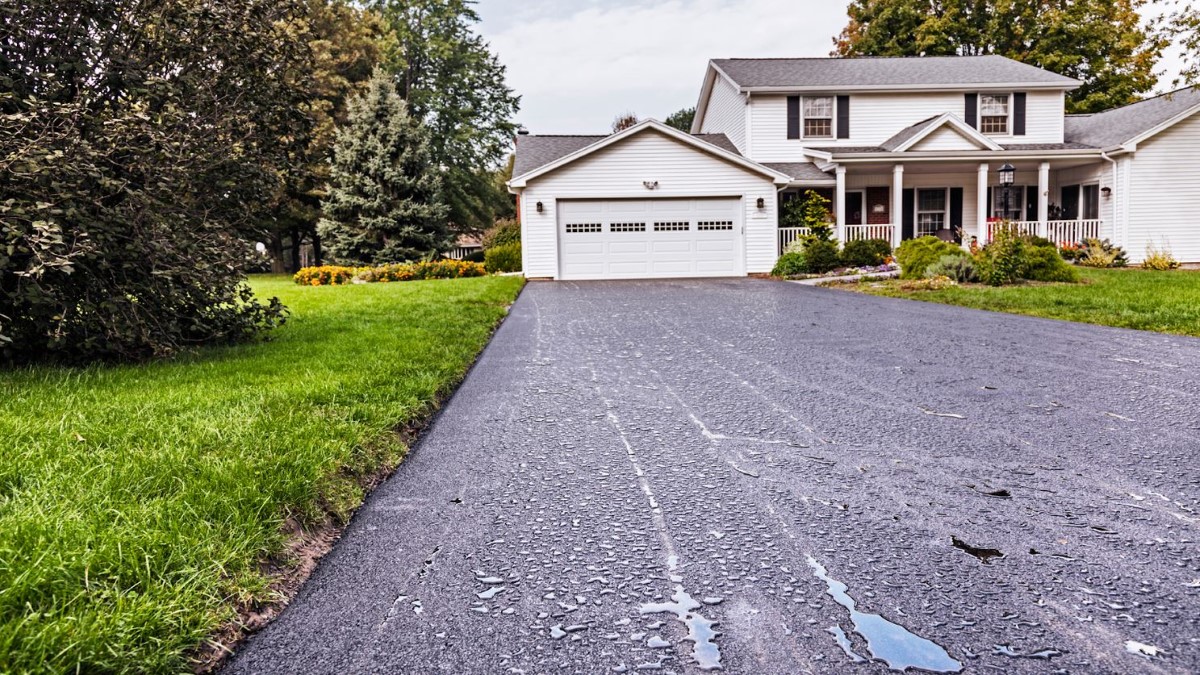If you’ve recently had a new asphalt driveway installed, you may be wondering how long you have to wait before driving on it. It’s essential to give the fresh asphalt enough time to cure properly before subjecting it to vehicle traffic. Failing to do so can damage your new surface, necessitating costly repairs. This article will provide you with the information you need to understand how long you should wait before driving on new asphalt.
What are the factors affecting the drying time of new asphalt?
1. Temperature and Humidity
These factors are essential to the drying times of new asphalt surfacing products.
The impact of temperature on drying time:
Temperature can influence drying times when installing new asphalt driveways, with warmer conditions drying faster than cooler ones. At too cold a temperature, fresh asphalt takes too long to cure correctly, which may result in uneven surfaces and reduced durability.
On the other hand, too-hot temperatures could result in cracks appearing quickly, leading to less durable results overall. For optimal asphalt drying conditions, temperatures between 70-80 degrees Fahrenheit would be most suitable.
Humidity effect on drying time:
Humidity can enormously impact the drying time of a new asphalt driveway. High humidity levels can slow the drying process and increase waiting time. When too much moisture remains in the air, moisture takes longer to evaporate from fresh asphalt surface layers; the ideal humidity range for new pavement should range between 40-70%.
Finding the ideal temperature and humidity for drying:
In order to find the optimum temperature and humidity conditions for drying asphalt driveways, it is necessary to follow weather predictions and adjust installation time accordingly.
In an ideal scenario, installations should occur during periods with low humidity levels and moderate temperatures to guarantee swift yet uniform drying times for all layers.
2. Thickness of the Asphalt Layer
How does thickness affect drying time?
Asphalt layer thickness can also play an impactful role in drying time. Thicker layers take longer to dry and cure than thinner ones and too thick layers could trap moisture or air, further delaying their drying. The optimal thickness depends on its intended use – residential driveways typically need 2-3 inch layers.
Finding an Appropriate Thickness for an Intended Use:
In order to select an ideal thickness for an asphalt driveway for any given use, it’s wise to consult a professional paving company that can assess site conditions and recommend an ideal thickness based on factors like anticipated traffic load, climate conditions, and drainage needs.
These recommendations can vary based on factors like climate variability and drainage needs, which will all impact what they suggest as appropriate thickness levels.
3. Asphalt Mix Used
Understanding Asphalt Mix Composition:
Understanding the composition of asphalt mix is also critical to its drying time, and selecting an appropriate mixture depending on its intended use and location can greatly speed up drying times.
Asphalt mixes consist of aggregates, sand, and bitumen in various combinations that affect drying rates – for instance, a higher ratio will typically dry faster. Also, consider that mix type can impact durability as well, so selecting an optimal one should always be done before choosing your mix type!
How does the ratio of components affect drying time?
The ratio of components can have an enormous effect on asphalt mix drying times. A mix containing more aggregates and sand will take longer due to its ability to retain moisture; on the other hand, bitumen-rich mixes tend to dry faster.
It’s essential that any individual seeking a professional contractor determine what combination would work best for the asphalt driveway in terms of use and location for their individual application and purposes.
Selecting the Appropriate Mix for Intended Use and Location:
When selecting the optimal mix for intended use and location, it is essential to consider factors like expected traffic load, climate conditions, drainage requirements, and drainage system restrictions. Professional contractors are well-equipped to evaluate these considerations and suggest the most suitable mixture.
4. Weather Conditions During Installation

Impact of Rainy Weather on Drying Time:
Rainy weather can significantly affect the drying time of new asphalt installations. It may wash away portions before they have had time to set or delay its drying process; additionally, rainwater seepage into the pavement could weaken it and lead to later cracking issues.
Therefore, if there is rain in the forecast, it would be wiser to postpone the asphalt driveway installation until conditions improve.
Cold Weather Affects Drying Times:
Colder temperatures can significantly slow the drying time of new asphalt pavement. When temperatures decrease, asphalt takes longer to set properly or may even fail altogether, leading to many complications.
To address the effects of cold weather on drying times, heaters or other methods may be used to increase temperature and promote drying; however, beware that such methods may prove costly and ineffective in all situations.
Finding the Ideal Weather Conditions for Installation:
Searching out the ideal weather conditions to install new asphalt can be challenging, yet essential in properly ensuring its drying and setting. Ideal conditions should include warm, dry weather with moderate humidity levels. Too hot temperatures could cause the asphalt to set too quickly and crack, while too cold could delay or prevent drying altogether.
Too windy conditions could prevent its proper setting, while too humid conditions could retain moisture that prevents drying altogether. It is wise to consult a professional asphalt contractor when determining the ideal time and place to lay out the new pavement in your region.
How Long Should a Driver Wait Before Driving on New Asphalt Surfaces?
General Rule for the Waiting Time:
Before driving on new asphalt pavement, a general rule of thumb for waiting time should be considered to be fully cured before driving. Depending on weather and other considerations, wait at least 24-48 or 72 hours. It is essential to maintain clean streets free of debris or foot traffic during this period – in hotter environments, this time frame may need to be extended even further before taking to it!
Factors That Affect Wait Times:
Various factors can alter the length of time until driving on new asphalt, including its thickness, type, weather conditions, and level of traffic on it. When these factors combine together, waiting times could either lengthen or shorten accordingly, depending on factors like these. When the asphalt layer is thin, weather conditions, particularly humid or cold, require it – however, when thick layers or more favorable warm and dry weather prevail, the waiting time could decrease considerably.
Consequences of Driving on New Asphalt Too Soon:
Driving too soon on new asphalt can have serious repercussions. Doing so could cause it to become uneven and lead to potholes or other damages, cracking the surface and possibly leading to water leakage issues and damage in other ways.
In addition, driving on it too soon can damage vehicle tires while creating skid marks, which may prove hard to erase in time.
Tips for Maintaining New Asphalt
1. Proper Care and Maintenance Following Installation
Proper care and maintenance of new asphalt are vital to its long-term durability and lifespan. After installation, it is vital to keep it free from debris, foot traffic, and sweeping; regular sweeping can prevent damage to its surface. In addition, seal coating should be applied every few years as an extra safeguard against water or other environmental damages that might affect it.
2. Maintain Regular Inspections and Repairs
Regular inspections and repairs are an integral component of maintaining new asphalt. Assessing signs of wear can help spot potential problems before they worsen; fixing cracks promptly can extend their lifespan and reduce costs in future repairs.
How to Prevent Damage to New Asphalt Paving?
Various steps can be taken to prevent a new asphalt driveway from becoming damaged. These include avoiding heavy vehicles and machinery from driving over it and taking care of tight turns and sudden stops. Avoid parking for extended periods, and not spilling gasoline, oil, or any chemicals on it.
Regular maintenance and cleaning will avoid damaging asphalt, extend its life, and keep its look for years.
Conclusion
Paving with a new asphalt driveway can be an investment worth making for any property owner, and understanding its recommended wait times prior to driving on it can save costly repairs in the future. The asphalt curing process varies depending on its type, the thickness of the layer, and weather conditions – by adhering to these waiting periods, you ensure a durable, long-lasting surface! Moreover, hiring a professional paving company will ensure the asphalt driveways are installed correctly. Antioch, TN is one of our primary service areas. If you live in Antioch, TN and are in need of professional asphalt or concrete services, please request a proposal!

